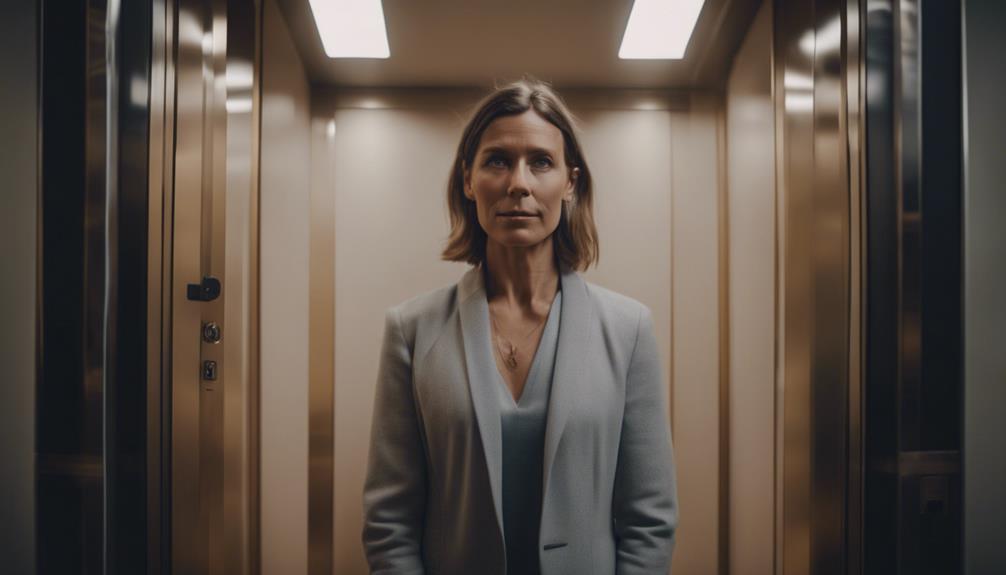
Claustrophobia, a distressing fear of enclosed spaces, can be effectively managed with hypnosis, EFT, and NLP. These modalities offer relaxation, subconscious reprogramming, and trigger management. Techniques like visualization, affirmations, and exposure therapy help create positive associations and challenge negative perceptions. By combining these methods, individuals can work towards overcoming their fear. Building inner strength, confidence, and resilience is key in this journey. Understanding the power of these tools to reframe one's mindset and confront fears is vital for progress. Discover how these approaches can empower you to face claustrophobia head-on.
Understanding Claustrophobia
Understanding claustrophobia is essential in order to provide effective treatment and support for individuals who experience this anxiety disorder. Claustrophobia, characterized by an irrational fear of confined spaces, can be triggered by various factors such as past traumatic experiences, genetic predispositions, or conditioned responses. Symptoms of claustrophobia may include panic attacks, sweating, trembling, shortness of breath, and a sense of losing control.
Coping strategies for managing claustrophobia often involve therapy treatments like cognitive-behavioral therapy (CBT), exposure therapy, and relaxation techniques. Hypnosis benefits individuals by helping them relax deeply, access their subconscious mind, and reframe negative thought patterns. NLP techniques can assist in changing limiting beliefs, while EFT applications aim to alleviate anxiety by tapping on specific acupressure points.
Visualization exercises, mindset shifts, and exposure therapy are commonly used to help individuals overcome triggers associated with claustrophobia. Combining modalities such as hypnosis, NLP, and EFT can offer a holistic approach to addressing and resolving claustrophobia effectively.
Hypnosis for Relaxation and Awareness

In the practice of hypnosis for relaxation and awareness, individuals can experience deep relaxation, allowing them to tap into their subconscious mind for healing.
This heightened state of relaxation often leads to increased sensory perception, enabling individuals to be more attuned to their emotions and physical sensations.
Through hypnosis, individuals can cultivate a profound sense of awareness and calmness, facilitating personal growth and overcoming challenges such as claustrophobia.
Deep Relaxation Benefits
Exploring deep relaxation benefits through hypnosis can greatly enhance one's overall sense of relaxation and awareness. Hypnosis offers a powerful tool for achieving profound relaxation, which can lead to stress relief and inner peace.
The benefits of deep relaxation through hypnosis include:
- Reduced Stress Levels: Hypnosis can help calm the mind and body, reducing stress and promoting a sense of calm.
- Improved Sleep Quality: Deep relaxation techniques can improve sleep patterns and help combat insomnia.
- Enhanced Focus and Clarity: By relaxing deeply, individuals can sharpen their focus and improve mental clarity.
- Boosted Immune System: Lower stress levels through relaxation can strengthen the immune system.
- Emotional Well-being: Deep relaxation can promote emotional balance and a greater sense of well-being.
Heightened Sensory Perception
Heightened sensory perception can be achieved through hypnosis, enhancing relaxation and awareness in individuals seeking a deeper connection to their senses.
By focusing on heightening awareness and sensory perception during hypnosis sessions, individuals can experience a heightened state of consciousness where they become more attuned to their surroundings and internal sensations. This increased sensitivity can lead to a greater appreciation of the subtle nuances in their environment and within themselves.
Through guided hypnosis techniques, individuals can learn to relax deeply, quiet the mind, and sharpen their sensory acuity. This heightened awareness can not only improve relaxation but also foster a greater sense of presence and mindfulness in everyday life, allowing individuals to experience the world in a more vivid and profound way.
EFT Tapping Techniques

To address claustrophobia effectively, understanding the basics of EFT tapping techniques is essential. This gentle yet powerful method involves tapping on specific meridian points on the body to alleviate emotional distress and promote relaxation.
When tailored to target claustrophobia, EFT can offer a practical and accessible tool for managing and overcoming this challenging condition.
EFT Basics Explained
Understanding the basics of EFT, also known as Emotional Freedom Techniques, can provide individuals with a practical and effective way to manage emotional distress through tapping techniques. EFT involves tapping on specific meridian points on the body while focusing on the emotional issue at hand.
Here are some key points to contemplate about EFT:
- EFT Overview: EFT is a form of psychological acupressure that aims to alleviate emotional and physical distress.
- Tapping Benefits: Tapping can help reduce stress, anxiety, and negative emotions by restoring the balance of the body's energy system.
- Simple Technique: EFT is easy to learn and can be done anywhere, making it a convenient tool for managing emotions.
- Self-Application: Individuals can practice EFT on their own once they understand the basic tapping points.
- Holistic Approach: EFT addresses emotional issues by combining tapping with verbal affirmations to promote healing.
EFT for Claustrophobia
For individuals struggling with claustrophobia, utilizing EFT tapping techniques can offer a practical and effective method for managing and alleviating feelings of distress in confined spaces. EFT, or Emotional Freedom Techniques, involves tapping on specific acupressure points on the body while focusing on the negative emotion or fear.
This process helps to disrupt the brain's pattern associated with claustrophobia, allowing individuals to reframe their thoughts and emotions. The benefits of EFT for claustrophobia relief include reducing anxiety levels, shifting focus away from fear, and promoting a sense of calmness and control in enclosed environments.
Rewiring the Subconscious Mind

By implementing techniques such as hypnosis, EFT, and NLP, individuals can effectively rewire their subconscious minds to alleviate feelings of claustrophobia. Subconscious reprogramming plays a crucial role in the mental transformation necessary to overcome this fear. Here are some key ways to rewire the subconscious mind:
- Visualization: Using guided imagery to create positive associations with enclosed spaces.
- Positive Affirmations: Repeating affirmations that instill feelings of safety and calmness.
- Anchoring Techniques: Associating a specific trigger, like deep breathing, with a state of relaxation.
- Regression Therapy: Exploring past experiences to understand and release underlying causes of claustrophobia.
- Self-Hypnosis: Learning self-hypnosis techniques to reinforce positive beliefs and reduce anxiety.
NLP Strategies for Overcoming Triggers

Utilizing Neuro-Linguistic Programming (NLP) techniques can empower individuals to effectively manage and overcome triggers associated with claustrophobia. NLP offers a range of strategies for trigger management and subconscious rewiring, enabling individuals to confront and alleviate their fears.
One powerful NLP technique for fear resolution is the 'Swish Pattern.' This technique involves mentally rehearsing a situation that triggers claustrophobia while simultaneously picturing a preferred, calm response. By repeatedly practicing this mental exercise, individuals can reprogram their automatic responses to triggers, replacing fear with a sense of control and calm.
Another NLP strategy is the 'Anchoring Technique,' where individuals associate a specific gesture or word with a positive emotional state. When faced with a trigger, they can use this anchor to instantly evoke feelings of relaxation and confidence. Additionally, the 'Visual-Kinaesthetic Dissociation' technique helps individuals detach from the intense emotions triggered by claustrophobia, allowing them to observe the situation from a more objective perspective.
Visualization and Exposure Therapy

To further empower individuals in overcoming claustrophobia, the application of visualization and exposure therapy techniques can play a pivotal role in gradually desensitizing individuals to triggering situations. Guided imagery allows individuals to create calming mental images to counteract feelings of panic in enclosed spaces.
Cognitive restructuring helps individuals challenge and change their negative thought patterns related to claustrophobia, promoting a more positive and realistic outlook. Exposure therapy involves gradually exposing individuals to feared situations in a controlled manner, helping them build tolerance and reduce anxiety over time.
Combining these approaches can be highly effective in helping individuals confront and overcome their claustrophobia. By incorporating guided imagery, cognitive restructuring, and exposure therapy, individuals can work towards redefining their relationship with enclosed spaces and reclaiming a sense of control and comfort.
Combining Modalities for Synergy

In the quest to enhance the efficacy of treatment for claustrophobia, integrating multiple therapeutic modalities can synergistically strengthen the individual's journey towards overcoming their fear. By combining modalities such as hypnosis, Emotional Freedom Techniques (EFT), and Neuro-Linguistic Programming (NLP), a more holistic approach to addressing claustrophobia can be achieved. These modalities work together to tap into the mind-body connection, acknowledging the all-encompassing nature of healing.
Hypnosis can help individuals access their subconscious mind to reframe negative thought patterns and responses related to confined spaces. EFT, through its focus on acupressure points and psychological exposure, aids in releasing emotional distress and anxiety associated with claustrophobia. NLP techniques provide tools for transforming limiting beliefs and behaviors, creating new pathways for positive change. When used in conjunction, these modalities complement each other, offering a multifaceted strategy for addressing claustrophobia from various angles.
This integrated approach not only addresses the symptoms of claustrophobia but also targets the underlying causes, promoting a more profound and lasting healing process. By harnessing the power of these modalities, individuals can initiate a transformative journey towards overcoming their fear of enclosed spaces.
Empowering Mindset Shifts

Fostering empowering mindset shifts is essential in the process of overcoming claustrophobia through integrated therapeutic modalities. Mindset transformation plays a pivotal role in reshaping one's perception of confined spaces, allowing individuals to navigate their fears with resilience and courage.
Inner strength development is a key component in instilling confidence and a sense of control when faced with claustrophobic triggers. Here are five ways to cultivate an empowering mindset shift in the journey towards conquering claustrophobia:
- Practice mindfulness techniques to stay present and grounded in moments of discomfort.
- Challenge negative thought patterns by reframing them with positive affirmations.
- Visualize success scenarios in claustrophobic situations to build confidence in managing fear.
- Engage in relaxation exercises such as deep breathing or progressive muscle relaxation to calm the mind and body.
- Seek support from a therapist or support group to process emotions and gain valuable insights into overcoming claustrophobia.
Frequently Asked Questions
How Long Does It Typically Take to See Results When Using a Combination of Hypnosis, Eft, and NLP to Overcome Claustrophobia?
Progress timeline varies based on individual factors. Therapist support vital for tailored approach. Identifying personal triggers is key. Developing coping strategies integral. Typically, noticeable improvements within a few sessions, with lasting results achievable after consistent effort and commitment.
Are There Any Potential Side Effects or Risks Associated With Using These Alternative Therapies for Treating Claustrophobia?
When exploring alternative therapies for treating claustrophobia, it is vital to assess potential risks alongside effectiveness comparison. Understanding the possible side effects and evaluating their impact on individual well-being is essential for making informed decisions about treatment options.
Can These Techniques Be Effective for Individuals Who Have Severe Claustrophobia or Have Had It for a Long Time?
For individuals with severe or long-standing claustrophobia, seeking a combination of therapeutic approaches like group therapy, medication, virtual reality exposure, and mindfulness techniques may be beneficial. Tailored treatment plans under professional guidance can offer significant relief and support.
Are There Any Specific Guidelines or Recommendations for Incorporating Visualization and Exposure Therapy Into a Treatment Plan for Claustrophobia?
When incorporating visualization techniques and exposure therapy for claustrophobia, it's essential to start with gradual exposure in a safe environment. Utilize relaxation methods to strengthen the mind-body connection. Progress slowly, ensuring the individual feels supported throughout the process.
How Can Individuals Maintain Their Progress and Continue to Overcome Their Fear of Claustrophobia After Completing a Program Using Hypnosis, Eft, and NLP Techniques?
To maintain progress post-treatment for claustrophobia, individuals should practice self-care like mindfulness techniques, join a support group for ongoing encouragement, and develop coping strategies for challenging situations. Consistent efforts and a strong support system are key.
Conclusion
To sum up, the integration of hypnosis, EFT, and NLP techniques offers a thorough approach to resolving the fear of claustrophobia. By rewiring the subconscious mind, overcoming triggers, and utilizing visualization and exposure therapy, individuals can experience a profound shift in mindset.
Imagine a world where confined spaces no longer evoke fear, but instead, inspire a sense of calm and empowerment. Through these modalities, liberation from claustrophobia is within reach.
Take the Next Step
Do not be afraid to reach out to me, Mark E Wilkins, to assist you in any issues you might have. Most Hypnotherapy sessions last 2 hours and EFT Sessions are usually handled with one session. Life Coaching is 45 minute session, once a week. Self-Hypnosis is taught in one session, and lasts a lifetime.
To make an appointment, first listen to the Pre-talk and fill out he Complementary Healthcare Provider Disclosure. The use the Contact Form to request an appointment with the Bohol Hypnosis Expert.
Self-help downloads are available. The self-hypnosis program to teach you how to self-hypnotize is here.





